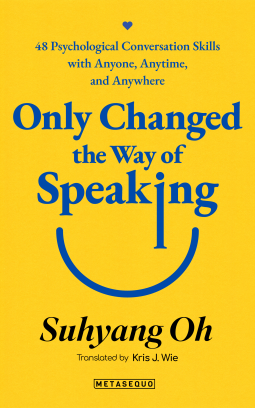
Only Changed the Way of Speaking
48 Psychological Conversation Skills with Anyone, Anytime, and Anywhere
by Suhyang Oh
This title was previously available on NetGalley and is now archived.
Send NetGalley books directly to your Kindle or Kindle app
1
To read on a Kindle or Kindle app, please add kindle@netgalley.com as an approved email address to receive files in your Amazon account. Click here for step-by-step instructions.
2
Also find your Kindle email address within your Amazon account, and enter it here.
Pub Date May 09 2022 | Archive Date Jun 26 2022
Talking about this book? Use #OnlyChangedtheWayofSpeaking #NetGalley. More hashtag tips!
Description
There is a reason for the captivating and enticing words!
Add ‘psychology’ to your speech
* Why do misunderstandings get worse the more we talk?
* How do we get the other person to say ‘Yes’?
* How can we speak so as not to get ‘No’ from the other person?
* How do we make others do what we want them to do through words?
* How do we make things work out smoothly through conversation?
* How can we strengthen our human relationships?
All conversations are psychological. Humans are 90% driven by psychology, and human psychology is 90% driven by words. Thus, understanding the psychological rules that move people’s minds and changing our way of speaking allows us to work better, and our relationships will change dramatically. If we use words properly, we can earn money, get along with our partners, and have a happy marriage. All we need is to add ‘psychology’ to our speech.
This book tells the ‘psychology of speech’ that moves people’s minds using 48 psychological skills, from the ‘Johari window’ in the mind that hinders communication to the ‘letter effect’ that excludes negative prejudices. It guides the know-how in detail about how we can make the other person behave or not when we use a certain way of speaking.
From now on, let’s change our way of speaking very slightly. That alone will positively change our life. No matter how shy or poor at speaking, if we practice with this book, we will be able to speak well enough.
A Note From the Publisher
As a communication expert, she has worked as a lecturer, coach, and columnist. She provides counseling and coaching on various topics such as conversational methods concerning the workplace, couples, and children, conducting more than 300 lectures a year at large corporations and public institutions.
She has appeared as a communication expert on numerous TV programs such as KBS, EBS, OBS, and SBS and conducted as a show host speech trainer for two years at GS Home Shopping. She has performed the ‘Oh Suhyang’s Leadership Course of Speech’ at Prime College, Korea Broadcasting and Communication University.
Her books include 'The Top Grades’ Conversation Habits', 'Secrets of People Who Say Everything While Laughing', 'People Who Get What They Want to Say in Three Words', and 'Habits of Positive Speech'.
Advance Praise
psychology guide to conversation skills
psychology guide to conversation skills
Available Editions
| ISBN | 9791197845109 |
| PRICE | $0.99 (USD) |
Links
Featured Reviews
 Reviewer 987103
Reviewer 987103
I started reading this book expecting to learn how to change my speech patterns, but I was pleasantly surprised to learn so much more. Despite the fact that the communication tips appear mundane, I enjoy reading it. Communication, like TPO in fashion, must be appropriate in terms of time, place, and occasion. But there are times when I just want to say whatever I want. As a result, I believe this book could be one of the sub-guidelines in daily communication.
Readers who liked this book also liked:
Mark Haefele; Richard C. Morais
Business, Leadership, Finance, Nonfiction (Adult)
Silvia Moreno-Garcia
Historical Fiction, Literary Fiction, Sci Fi & Fantasy









